The Confidential Report - May 2025
7 May 2025 By PDSNETAmerica
When Trump took over on the 20th of January 2025, he took over an economy that was booming and a stock market that was breaking new record highs. He derailed that with his tariffs and caused a 19% correction. The correction was totally a result of his interference in an otherwise strong upward trend – and so when he, predictably, began to back-pedal on his tariffs, the market began to recover. And that is where we are now. Consider the chart:
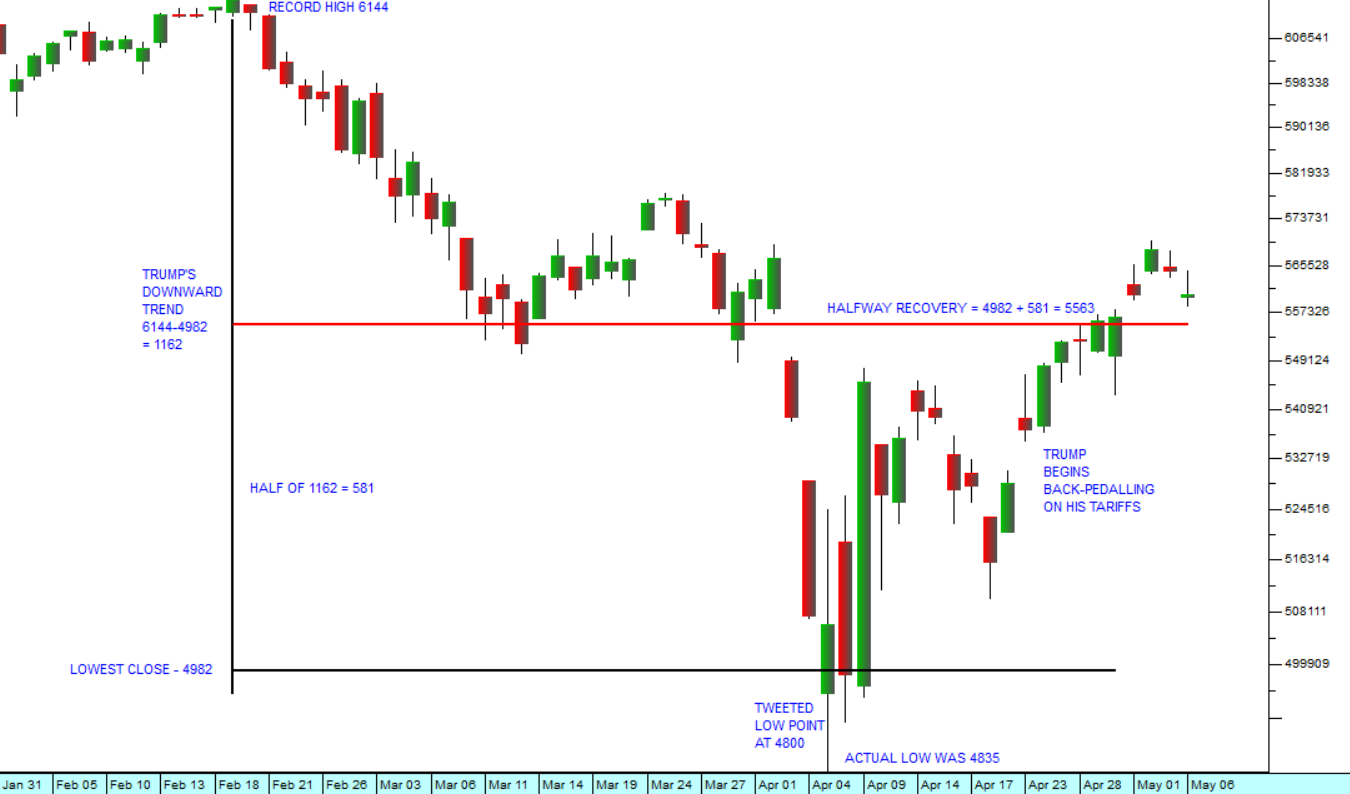
The chart shows that from its high point of 6144 on the 19th of February 2025, the S&P500 fell 19% to a low of 4982 on the 8th of April 2025 – a drop of 1162 points or almost 19%. Since then, the S&P has recovered 704 points or 60% of what it lost. Just as the fall was entirely due to Trump’s tariffs, this recovery has been entirely because he has changed his mind and is now trying to undo some of the damage which he did.
From a technical perspective, strong downward trends like this usually take place in three waves known as “A,” “B” and “C.” “A” is the initial downward move, “B” is a 50% recovery of that move and the “C” is the final collapse down to a point known as capitulation where the so-called “weak hands” among investors simply give up on the market and abandon it.
For this reason, the 50% recovery point is of great interest to technical analysts. They are looking to see whether the “C” leg of the downward trend will materialize. But as of Friday last week the S&P had recovered 60% and the probability of a third leg down was fading. The further the recovery goes now the less likely it is that there will be a “C” leg down – and that is good news.
Of course, the recovery shows that investors are becoming increasingly confident that Trump’s announcements on Liberation Day were just a lot of hot air and that he was never going to implement a worldwide trade war.
This realization has resulted in a growing number of investors seeking once again to “buy the dip” and capitalize on the increasing probability that the S&P500 index will break to a new all-time record high in due course.
What has been notable is that investors on the JSE never really believed in Trump’s correction and did not take seriously what was taking place on Wall Street. This can be clearly seen in the progress of the JSE Overall index which only responded briefly to Trump’s Liberation Day announcement and then resumed its record-breaking streak – showing that local investors have never really believed that Trump would be able to stick to what he proposed.
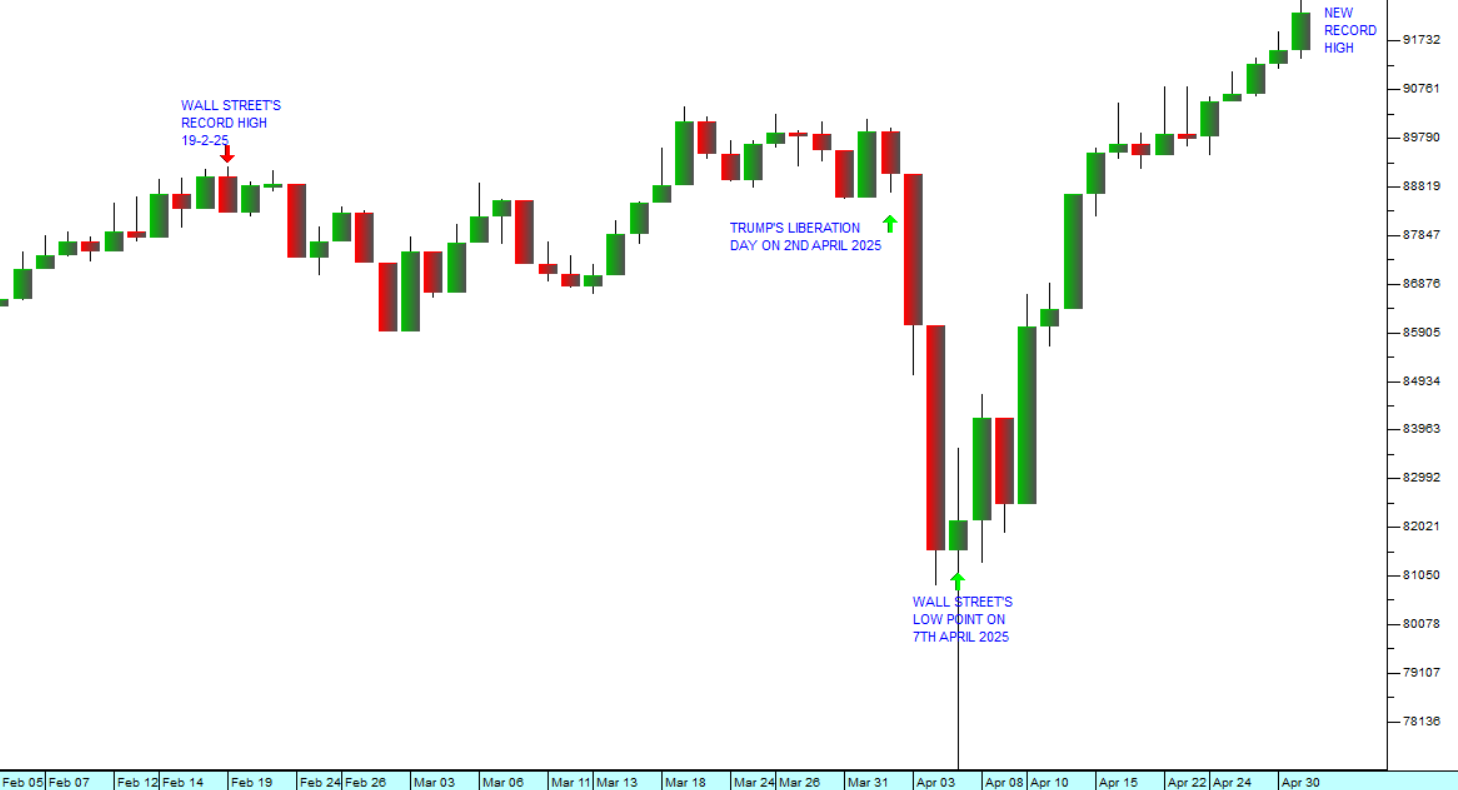
It is becoming more and more apparent that the American economy is in the process of completing the “soft landing” which was always the goal of Jerome Powell and the Federal Reserve Bank. Certainly, there has been some slowing down of growth, with gross domestic product (GDP) shrinking by 0,3% in the first quarter of 2025 – but that was mainly caused by companies increasing imports by 40% ahead of what they feared might be a highly restrictive tariff regime combined with a sharp drop in both consumer and government spending (this latter because of Musk’s DOGE cuts).
More evidence of a soft landing for the economy came from the jobs report for April month 2025 which showed that the US economy created 177000 new jobs in the month – less than the 228000 recorded in March, but markedly better than the 133000 than economists were predicting. The unemployment rate was steady at 4,2%. These figures paint a picture of an economy that is still growing – perhaps not as quickly as it was, but probably not heading into recession, despite Trump’s tariffs. In our view, the underlying forces which have been powering the bull trend remain intact – the productivity gains flowing from artificial intelligence, the spread of smart phones, the development of humanoid robotics and the drop in energy prices because of the spread of mainly solar power. All that was required for the bull trend to resume was that Trump back down on his tariffs – which is exactly what he is doing.
And the situation is, of course, is a far cry from the Atlanta Fed’s prediction of a 3,7% drop in GDP made immediately after Trump’s Liberation Day announcement . At that time, it was estimated that the cost of manufacturing a vehicle in the US would increase by between $3000 and $12000. Perhaps the clearest indicator of the impact of Trump’s actions was the price of General Motors shares on Wall Street – they fell by over 8% with the announcement.
After Liberation Day, Goldman Sachs was predicting a 35% chance that the US economy would enter a recession. They said that the Federal Reserve Bank would have to cut interest rates three times during 2025 and that US growth from 2025 will slow from 2% to 1,5%. They predicted that the S&P500 would finish the year at 5700 – sharply down from their previous prediction of 6200. This was all based on their forecast that average US tariffs would increase by 15% in 2025. They also predicted that the European economy would also fall into a recession. And all of this was because of Trump’s trade war with Europe and the rest of the world.
The International Monetary Fund (IMF) also reduced its global growth forecast for 2025 from 3,3% to 2,8% with the US growth rate falling to 1,8% down 0,9% - with a 40% probability of entering recession. They predicted that South Africa’s forecast growth rate would be 0,5% lower at 1%. This sharp reduction was obviously due to the massive tariffs which Trump has imposed, and the growing list of reciprocal tariffs imposed by affected countries, especially China.
The 145% tariff on Chinese goods entering America and the 125% tariff on US goods entering China would effectively bring the trade between the world’s two largest economies to a halt, but predictably, Trump is now back-pedalling on what he has said about China. In an almost complete reversal of his earlier position, he is now talking about trade negotiations with China.
It is no secret that Trump does not like the way that Jerome Powell, Chairman of the Federal Reserve Bank (The Fed), is managing interest rates. Trump wants Powell to slash rates to help compensate for the negative impact of his tariff policy on the US economy. The Fed, of course, is independent of the Executive branch of government in America (as is true for most central banks) and Trump cannot legally fire Powell, who is due to serve until May 2026. However, Trump’s negative comments about Powell introduced a new element of uncertainty into financial markets around the world causing them to fall further. It is unheard of for US Presidents to involve themselves in the management of the country’s monetary policy or even to comment on the level of interest rates – so Trump’s aggressive stance threatens the stability of the entire financial system generally.
It is notable that the central banks of the world have been dumping their holdings of US dollar investments which are now down from 66% in 2015 to 57,8% in the last quarter of last year. This shows that central bankers are gradually reducing their reliance on the US dollar and moving to other assets in a process of “de-dollarization.” This process has been given new momentum by Trump’s erratic and unpredictable tariff policies and his attacks on the Federal Reserve Bank’s independence. Central bankers have lost some of their confidence in US Treasury Bills as a secure asset and are moving to European government bonds or gold. The damage done by Trump to the US economy is taking the form of lost confidence and the realization that American economic policies are no longer reliable. The American government has about $29 trillion in bonds about 30% of which is held by foreign nationals.
Trump’s first one hundred days in office saw the collapse of both equity and bond markets in America and a sharp decline in his approval rating which has fallen to the lowest level ever for any US President at this point in their Presidency. He has attacked the media, the universities and the Federal Reserve Bank while orchestrating the illegal deportation of immigrants without due process and failing to negotiate any sort of permanent cease fire in Ukraine. In our view, the Republicans will lose both the House and the Senate in the mid-term elections leaving Trump as a “lame dog” president.
One notable result of all this turmoil is the collapse of Tesla shares. Its latest results for the first quarter of 2025, show that its sales are declining while it faces protest action at dealerships across the country due to Musk’s involvement in the Department of Government Efficiency (DOGE). It is also facing stiff competition from other producers of electric vehicles like the Chinese company BYD. It is clear to us that Tesla is suffering from Musk’s lack of focus on the business. Its share price peaked on 17th December 2024, when the euphoria over Trump’s election victory was at its height, and it has been declining since. So far it has lost about half of its market capitalization.
Ukraine
Russia’s latest 3-day unilateral ceasefire is designed to ensure that Ukraine does not use drones to attack Moscow during the May 9th “Victory” celebrations. The ceasefire is from 8th to 11th May to give visiting heads of state time to arrive and leave without fear. Among them is Xi Jinping, President of China – which means it is unlikely that Ukraine will attack. But the war goes on. Trump has been completely unable to negotiate any kind of ceasefire with Russia even though Ukraine accepted the American ceasefire proposals nearly two months ago. It is clear that Putin does not want the war to stop. He probably fears that as soon as the war stops, people inside Russia will begin to motivate to have him removed from office.
At the same time, Ukraine has just signed an agreement with America for the exploitation of its mineral resources. President Zelensky describes it as a “truly equal agreement” which will benefit both Ukraine and America. It seems that Trump is in the process of reversing his pro Russia stance. He has obviously suffered a significant loss of face because of not being able to stop the Ukraine war when he came into office. Most Americans believe that the US should be supporting Ukraine in its effort to win the war.
Putin has been forced to announce a further conscription of 160000 troops clearly showing his intention to continue with the war and Europe must respond. The fact remains that Europe simply cannot allow Putin to win this war, and they are moving steadily towards putting European troops on the ground in Ukraine. That is the next logical escalation of the war, and we believe that it is imminent.
At the same time Russia’s ability to continue prosecuting the war is now in doubt. Their economy is in a crisis with inflation estimated unofficially at 70% and 21% interest rates.
One notable consequence of Trump’s international trade war is that it has pushed the oil price down further with dire consequences for Russia. Consider the chart:
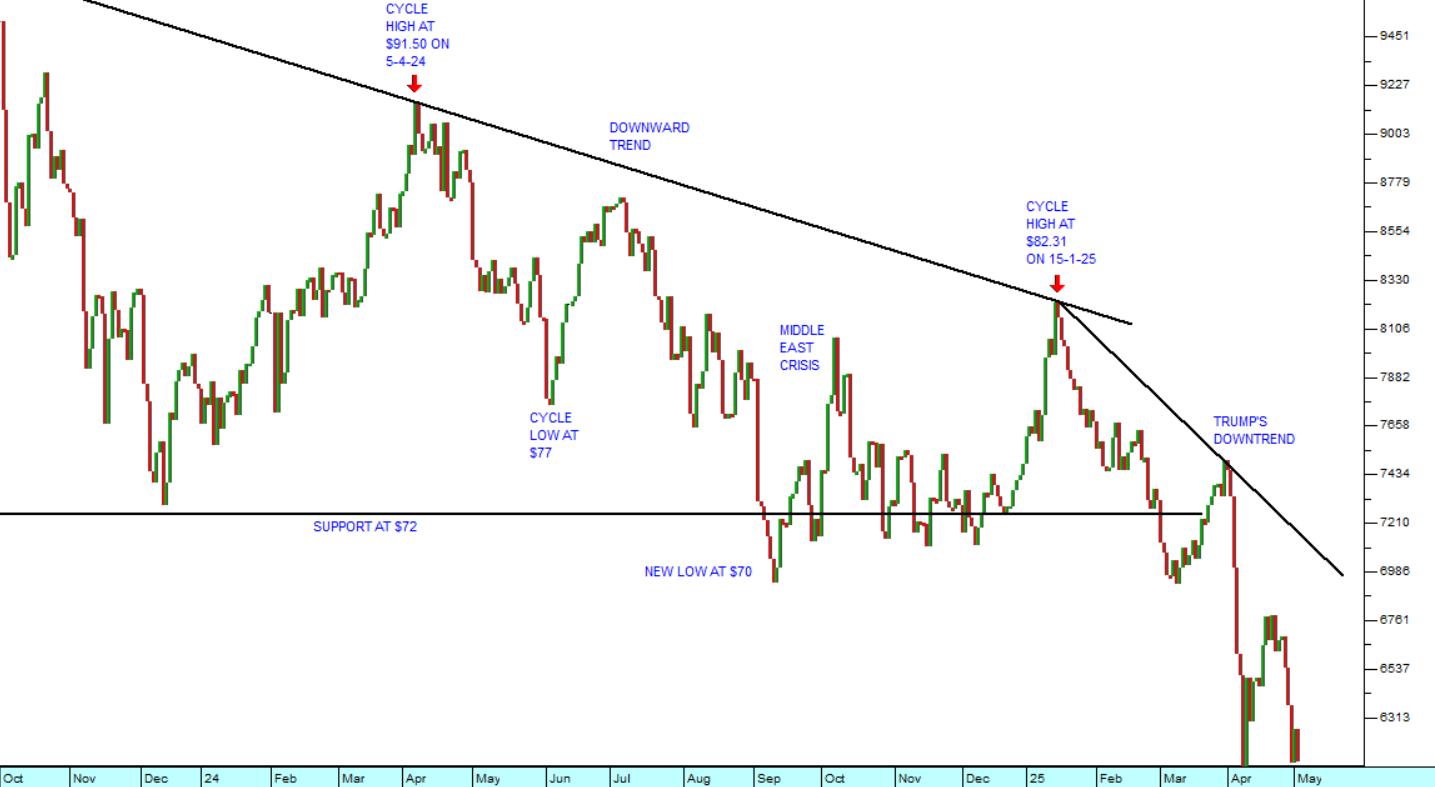
The chart shows how the price of North Sea Brent has dropped through the long-term support level at $72 and is now trading at a new low of $61. This is unbelievably bad news for Putin and Russia as it severely limits the funds which he has to continue prosecuting the war. In our view, Russia will not be able to continue this war into 2026.
Political
The DA’s decision to vote against the Budget framework on 2nd April 2025 shook the foundations of the government of National unity (GNU). It began with the ANC’s 2% VAT increase, which was then reduced to 0,5% and finally removed altogether. There can be little doubt that the process has been bad for the ANC and good for the DA. Both parties have accused the other of being disingenuous, but very few voters in South Africa were in favour of a VAT hike. Notably, Judge Dennis Davis, who is a tax expert, said that even the 0,5% VAT increase was unnecessary because the R13,5bn that it would yield can easily be found elsewhere in the R2 trillion budget. Ultimately, the ANC has been forced to back down which is a clear victory for the DA.
The latest poll from the Institute for Race Relations (IRR) shows the ANC with 29,7% support while the DA is at 30,3%. This is the first time that an IRR poll has shown the ANC lower than the DA and probably indicates the general dissatisfaction with the ANC’s proposed 2% increase in the VAT rate. Clearly, the ANC has continued to lose ground following the election where it received just over 40% of the vote. At the same time, it seems possible now that the DA could gain ground in future elections. South African voters are more focused on service delivery than populist dogmas and the ANC’s track record in the struggle to end apartheid.
Talks between South Africa and America on their trade relations have commenced. These talks are apparently being led by the Trade, Industry and Competition minister, Parks Tau, and will encompass South Africa’s standing in the African Growth and Opportunity Act (AGOA). Trump’s 25% tariff on SA imports has been temporarily suspended. Our main export to America is platinum group metals (PGM) and America imports a substantial number of motor vehicles from this country. Our objective would be to eliminate trade barriers between the two countries, but that might set a dangerous precedent for Trump with other countries. We have always held the view that Trump would back down on his tariffs eventually.
The South African Reserve Bank (SARB) economic model shows that, in a worst-case scenario, where AGOA is cancelled and America places 25% tariffs on South African imports, gross domestic product (GDP) could fall by as much as 0,7%. Obviously the Ramaphosa administration will do what it can to prevent this but given the poor state of SA/US relations that might be difficult. The Bank estimates that the rand could fall by as much as 15% causing inflation to increase by 1,25%. All of this would be very bad for the economy and snuff out the benefits of the GNU and the end of loadshedding. However, this is a worst-case scenario, and it is likely that some compromises will be reached.
Economy
The effect of Trump’s 30% tariff on South African exports to America, if implemented, will have an impact on our motor industry, because it is in addition to the 25% tariff on motor vehicles and parts already announced by Trump. The tariffs on 50 African countries also probably mean the end of the African Growth and Opportunity Act (AGOA) and the benefits that South Africa has enjoyed in terms of that law. Our agriculture sector will also be impacted since we export a lot of farm produce to America. Notably, our raw materials like platinum group metals (PGM), gold, chrome, and other metals are excluded from Trump’s tariffs and the South African government has adopted a conciliatory position so far by talking of a bi-lateral agreement and not suggesting reciprocal tariffs on America. No doubt, however, the tariffs announced by Trump on 2nd April 2025, if implemented, will have a negative impact on South Africa’s GDP growth.
The motor industry in South Africa exported 25500 new vehicles and parts worth R35bn to America in 2024 – which was 30% more than in 2023. These exports are directly impacted by the 25% tariff which Trump has declared on vehicle imports into America. This means that Americans will have to pay 25% more for South African made motor cars and will obviously result in lower sales. The tariff applies to all vehicles imported into America so by comparison, US-made vehicles will have a 25% price advantage. At this stage it is difficult to estimate the impact of this on the SA motor industry, but it will be significant. Fortunately, South Africa has other markets for its vehicle exports – America is only our third largest market. Altogether South Africa exports about R270bn worth of vehicles and parts every year- so America accounts for just over 10% of that.
Sales of new vehicles in March 2025 were up 25% over the same month last year. For the March quarter sales were up just over 10% compared to the same quarter last year. Sales of light commercial vehicles and bakkies (including mini-bus taxis) were down 8,4%. March is the sixth month in which sales of vehicles have increased. Obviously, the declining pattern of interest rates and the end of loadshedding have improved the market for vehicles. South Africa’s continued membership of AGOA remains a critical issue for the motor industry.
Manufacturing production fell by 3,2% in February, mainly because of a 15% drop in motor vehicle and parts production. This comes after a 3,3% decline in January. Obviously, the motor vehicle sector is bearing the brunt of the Trump tariffs and will suffer further if America abandons the African Growth and Opportunity Act (AGOA). It is apparent that the impact of reduced loadshedding is no longer a major positive.
The consumer price index (CPI) for March 2025 came in at 2,7%, down from February’s 3,2% and well below economists’ forecasts of around 3%. Inflation is now below the lower limit of the Reserve Bank’s target range of 3% to 6% - which opens the way for further interest rates cuts. Rates were held unchanged at the March meeting of the Monetary Policy Committee (MPC) and the next meeting is only due this month. Given the volatile state of the international economy and the prospect of tariffs on South African exports to America it is unlikely that rates will be reduced in May, but there is a strong possibility that rates will come down after that. A surprising drop in rentals and education costs were some of the drivers of March’s lower CPI.
The BankServ take-home pay index showed that the average take-home pay in South Africa was 2,5% lower in March than in February 2025. Take-home pay dropped to R17800, but this was still 11,4% up on the same month last year. This means that salary-earners are nearly 9% better off in real terms (i.e., after inflation) than they were last year. The consumer price index has been falling rapidly and reached 2,7% in the year to the end of March 2025. The decline in inflation is having an enormous positive impact on consumers’ spending power. The additional money will help to alleviate higher taxes as the budget this year did not adjust for bracket creep.
Private sector credit extension (PSCE) was up 3,68% in the year ended 28th February 2025 – lower than year to January’s 4,59%. PSCE was unchanged in the month of February itself. PSCE is the total amount of credit given to households and businesses in the form of loans or advance or other credit. As such it shows the level of optimism in the economy. When consumers and businesses are lacking confidence, they tend not to take out further loans and vice versa. Household credit only grew by 2,7% while companies extended their loans by 5,1%. This shows that consumers are remaining conservative in a difficult economic environment where there are areas of uncertainty and interest rates remain high. Credit card credit was 8,4% up, which is less than January’s figure of 8,8% while mortgage bond credit was unchanged for the third month in a row.
The ABSA Purchasing Managers Index (PMI) increased by four points to 48,7 in March 2025, but remained below the 50 level which shows that the sector is still shrinking. The average PMI for the first quarter of 2025 was 46,2. Business activity and new sales were up sharply with issues at ports remaining a major problem. The 12,7% increase in Eskom’s electricity charges from 1st April will have a negative impact on productivity in the sector. Despite this, there are signs that manufacturing is beginning to perform better.
The rising cost of electricity from Eskom has forced mining companies to commission their own renewable energy installations. Sibanye has recently commissioned South Africa’s largest private wind farm which is expected to deliver 309 gigawatt hours of electricity per annum and is one of four separate projects which Sibanye is developing. Amplats, now called “Valterra Platinum,” is busy with a 100mw solar farm and various other large mining groups are doing the same. Obviously, each large user that abandons Eskom makes that company’s position more difficult. Eskom is also now faced with the development of new private energy suppliers that will make use of the distribution network through the newly separate distribution company. In our view, Eskom is a dying enterprise.
SARS has collected R8,8bn or 6,6% more than they estimated for the 2024/25 year. This is above the nominal increase in GDP of just under 5%. The tax base now consists of thirty-three million taxpayers. The personal income tax collected increased by 12,6% and corporate tax by 2% while VAT increased by 2,3%. Lower imports and fuel consumption reduced collections, but SARS’s compliance program increased collections. R47,7bn was released as a result of the 2-pot retirement system and that yielded tax of R11,9bn. [BD8] Edward Kieswetter, who runs the South African Revenue Service (SARS) says that South Africa has about 16 million employed people, but only about half of that number earn enough to be eligible for tax. At the other end of the scale between 3,5% and 4% of taxpayers who earn above R560000 a year pay almost half of all tax collected from individuals. This shows how narrow the tax base is and how dependent it is on a relatively small number of people who are paying the lion’s share.
The Rand
In our view, the collapse of the rand to levels above R19 to the US dollar, while impacted by the problems in the GNU with the third revision of the budget now in progress, is primarily due to a sharp switch to “risk-off” in international markets, following Trump’s so-called Liberation Day tariff announcement. As one of the most liquid emerging market currencies, the rand is at the forefront of international investor sentiment and responds immediately to any changed perceptions of emerging markets, even if they have little or nothing to do with South Africa. We believe that the rand will continue to recover as Trump backs down on his ridiculous tariff policies and adopts a more reasonable and trade-friendly approach. Consider the chart:
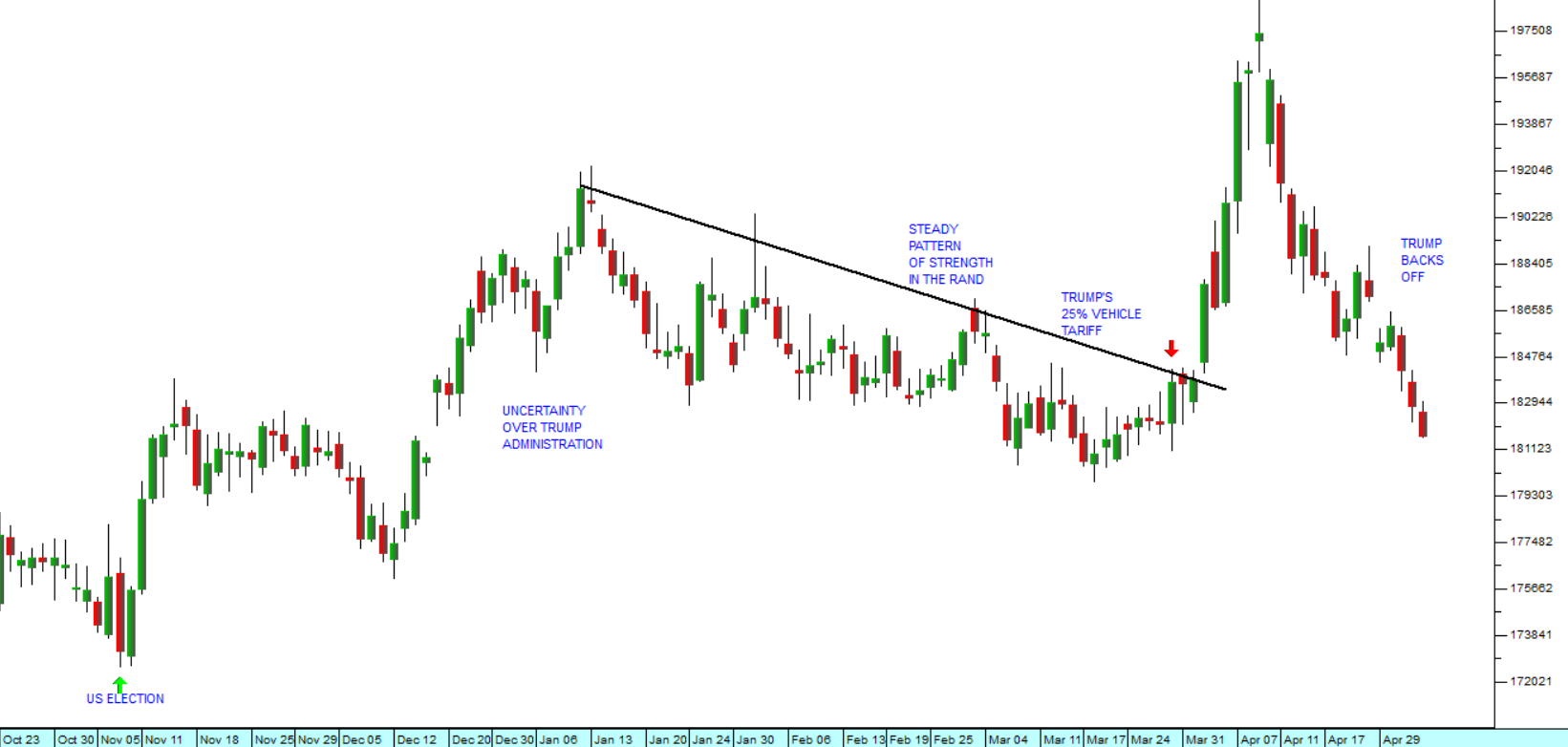
From the election of Trump on 6th November last year, the rand together with other emerging market currencies has been weakening – mainly due to uncertainty about what he would do. There was a period of relative stability from 10th January to the end of March 2025 during which there was rising hope that he would not do anything stupid. During this period, the rand strengthened steadily.
Then at the end of March Trump announced his 25% tariffs on all imports of vehicles and vehicle parts into America – and this was followed by his absurd Liberation Day announcement of tariffs on almost every country in the world. The effect was to take the rand remarkably close to a new record low against the US dollar.
As indicated above, from South Africa’s perspective, the most immediate impact of the Trump tariffs was a sharp move towards “risk-off” in the international investment world. This took the rand down to an intraday low of R19.93 to the US dollar on 9th April 2025. Since then, as Trump has backed off, the rand has been appreciating rapidly and is now back to R18.42.
We believe that the rand will continue to strengthen, especially given the low level of South African inflation and the high level of local interest rates. This means that overseas investors can get a very solid real return. The 10-year SA government bond is currently yielding about 10,6% and inflation is at 2,7% - so overseas investors are looking at a real return of nearly 8% - probably one of the most attractive returns in the world today.
So, we see the rand continuing to appreciate steadily back towards the September 2024 low of R17.11 to the US dollar.
Gold
Since breaking above resistance at $2060 in March 2024, the gold price has been in a strong upward trend which was accelerated by Trump’s election in November 2024. Consider the chart:
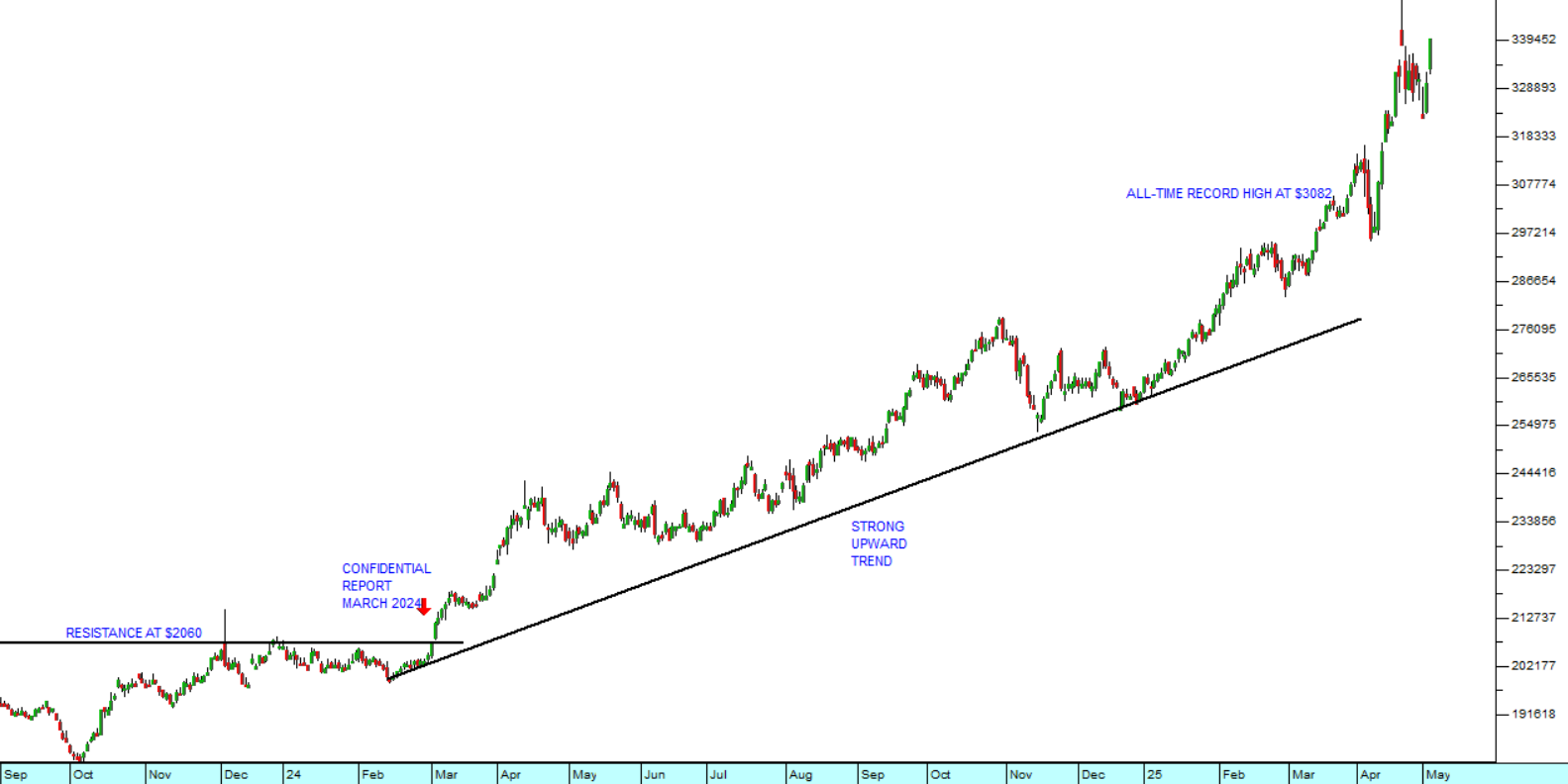
You can see that after the 2nd of April 2025, the upward trend continued and eventually reached an intraday all-time record high of $3500 on 22nd April 2025. Since then, as Trump has steadily backed down on his international trade war, the gold price has been falling and is now back to $3230.
You will notice that most of gold’s gain remains in place as international investors and central banks switch out of US Treasury bills. We expect the upward trend in gold to continue in due course.
Companies
NEW LISTING
Later this year the tech company ASP Isotopes intends to list on the JSE. ASP has three factories in South Africa where it refines carbon 14, silicon 28 and ytterbium 176 mainly for medical and pharmaceutical use as well as quantum computing and semiconductors. The company has been listed on the NASDAQ in America since 2022 and has a market capitalization of about R7,4bn ($400m). We believe that this will be a good blue-chip addition to the JSE offering investors a new avenue of investment.
4SIGHT (4SI)
We originally added 4Sight to the Winning Shares List on the 4th of August 2024 at 31c. It peaked six months later at 110c and then fell back to find support at 60c. Consider the chart:
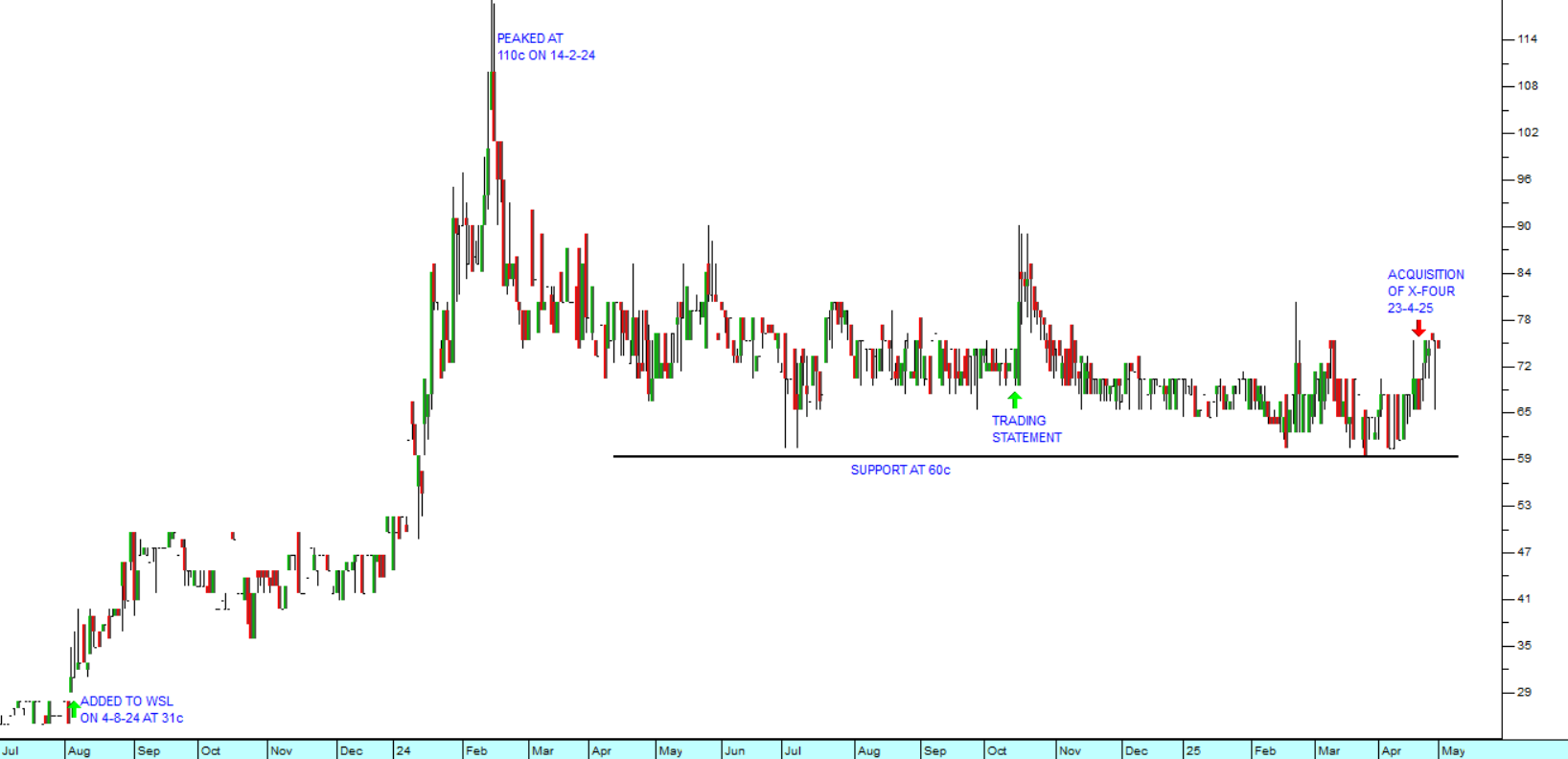
For the past year, the share has been moving sideways despite the excellent results that it has been reporting. On the 16th of October 2024, the company estimated in a trading statement that headline earnings per share (HEPS) would rise by between 31% and 40% for the six months to 31st August 2024. They in fact came in up 35,5%. A few days ago, on the 23rd of April 2025, the company announced that it had acquired 100% of X-Four for R21,2m to be paid half in cash and half in shares. X-Four is a human resources and payroll company with customers in 20 African countries. It is expected to widen 4 Sight’s customer base and bring important skills in AI to the group.
We see 4Sight as a small IT group that is growing rapidly, both organically and by acquisition. We do believe it will not be long before it is recognized as a solid investment by the big institutions.
CAPITEC (CPI)
Capitec is about to become the bank with the highest market capitalization in South Africa as its share price continues to power ahead. At the end of April 2025, the company had a market cap of R404,5bn – just slightly less than FNB’s market cap of R410,8bn. Since it started just over 20 years ago, Capitec has grown rapidly. It now has the largest number of customers with twenty-four million and its value has risen by more than 400% in the last 5 years. Consider the chart:
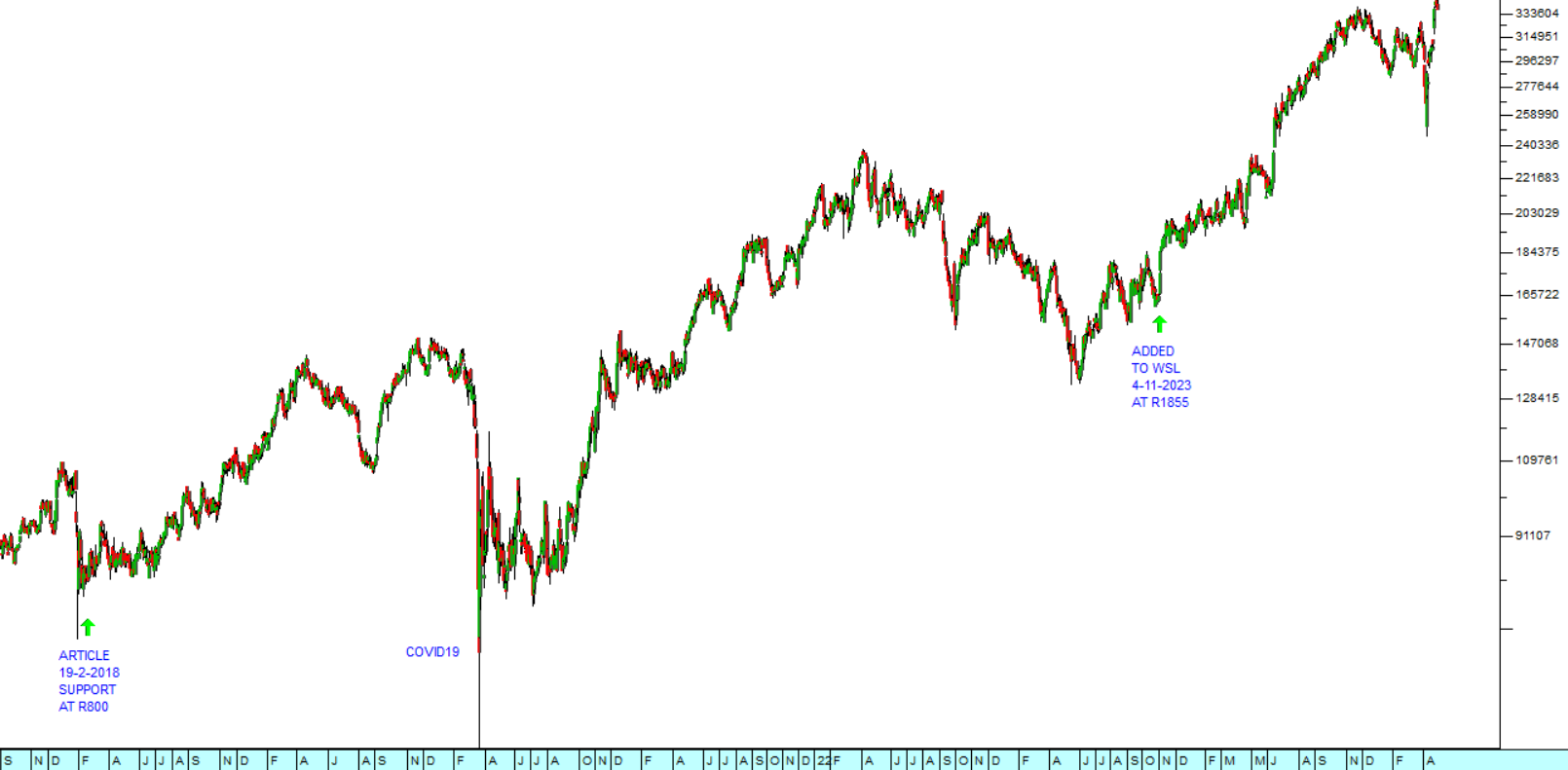
In the year to the 31st of December 2024 the company reported a stunning 29% return on equity which is the best of the large banks in South Africa, and it recorded a record after tax profit of R13,7bn. Headline earnings per share (HEPS) rose by an amazing 30%. We first wrote about Capitec and recommended it in an article on the 19th of February 2018 when the share was just R800. Later, we added it to the Winning Shares List on the 4th of November 2023 at R1854.96c and it has since risen to R3406.90c – a gain of 83,6% or 55,72% per annum – excluding dividends. We still believe that it is one of the best investments on the JSE.
BLUETEL (BLU)
Bluetel is a company that sells secure tokens of value – like airtime, starter packs and electricity. It is now recovering from its decision to buy 45% of Cell-C in 2016 and the share has been performing very well. We originally recommended it when it broke up through its downward trendline on the 29th of February 2024 at 360c per share and we subsequently added it to the Winning Shares List (WSL) on the 23rd of January 2025 at 610c. Since then, it has risen to 850c – a gain of 39,3% in just over three months. Consider the chart:
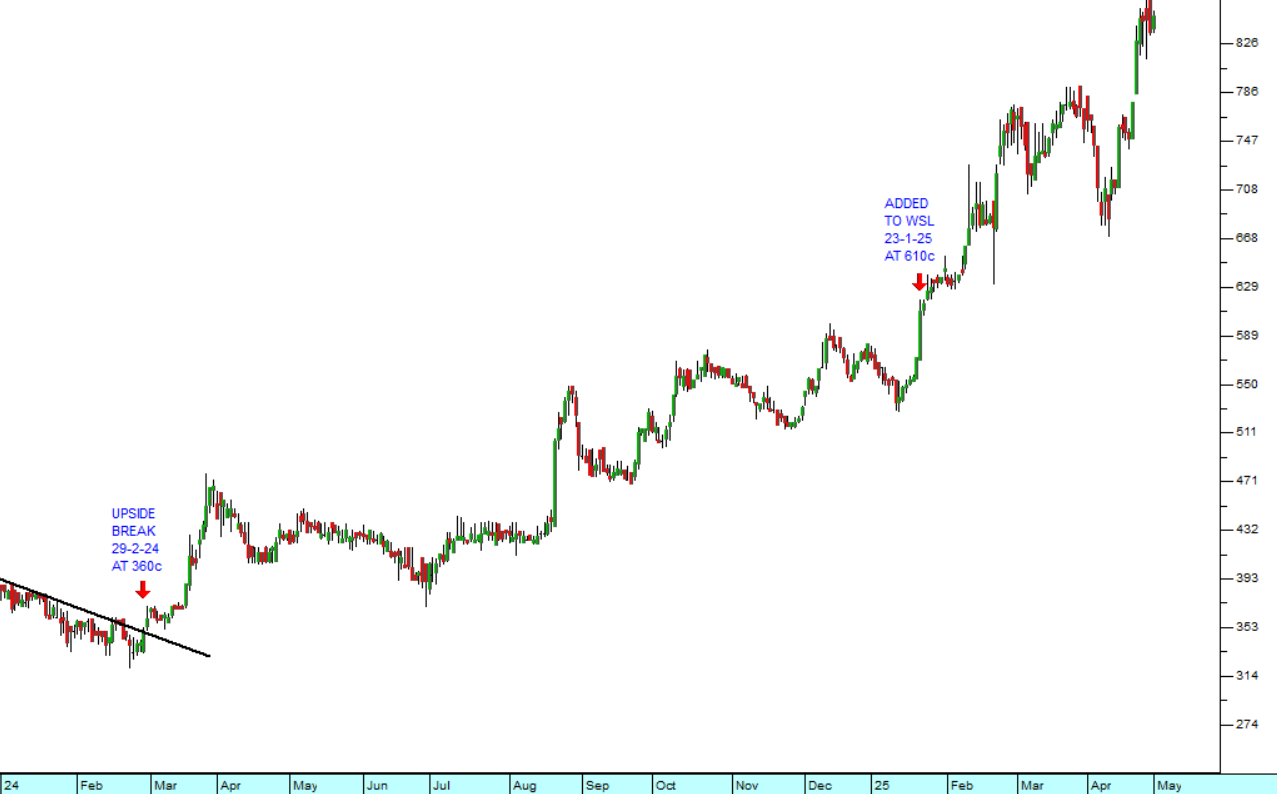
KORE (KP2)
This company mines potash at its Sintoukola site in the Congo. The location of this mine makes it a very volatile and highly speculative investment. We first added it to the Winning Shares List (WSL) on the 16th of May 2024 at a share price of 20c. since then it has reached a high of 83c on the 3rd of October 2024 before falling back. Consider the chart:
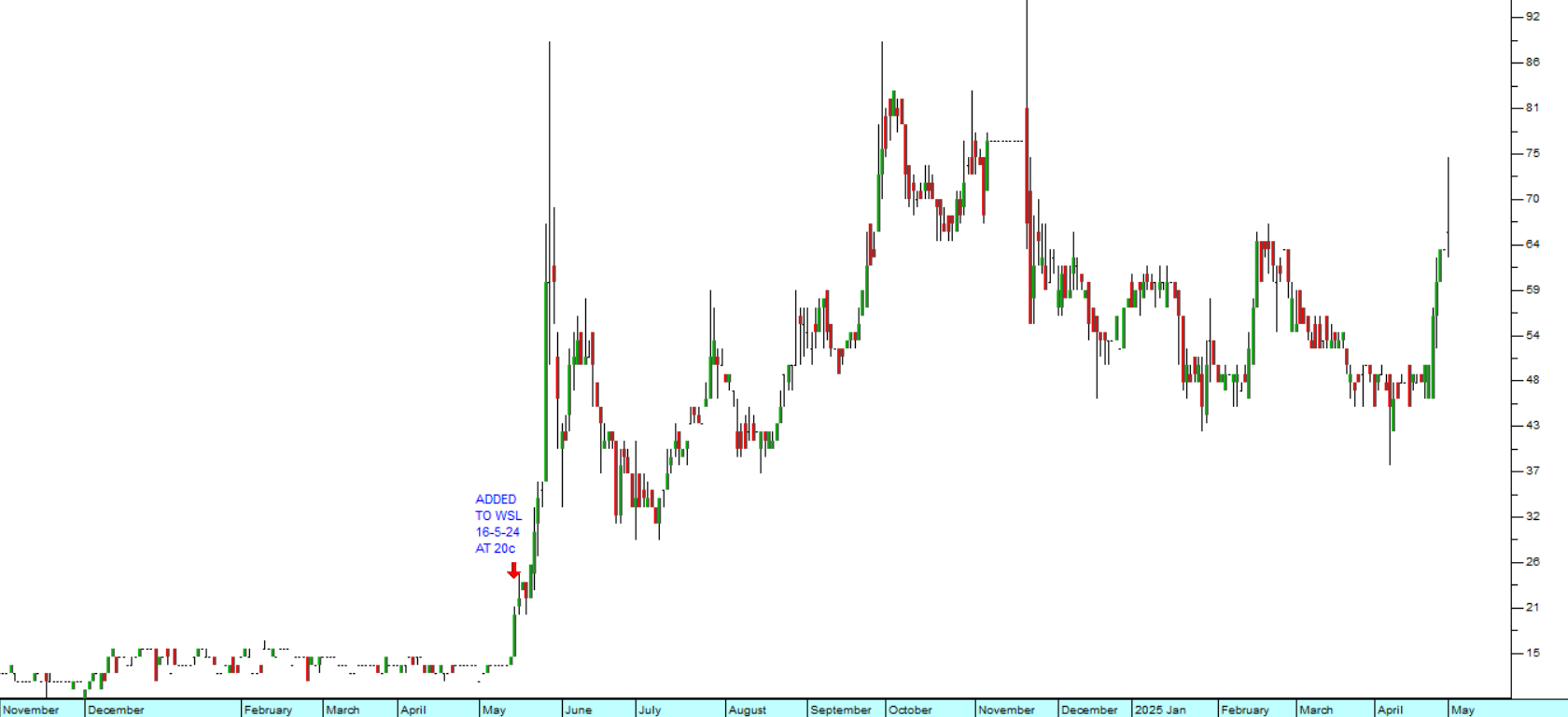
We added it to the WSL because it had broken up unexpectedly on strong volumes after an extended period of sideways movement. Since then the share has been very volatile, but we remain confident of its long-term potential. In recent days, the share has begun climbing again and is now back at 66c. Obviously this is more of a speculation than an investment, but it has the potential to give a significant capital gain. Since we added it to the WSL it has risen by 230% in just less than a year.
PAN AFRICAN RESOURCE (PAN)
Pan African Resource is a gold re-retreatment company listed both on the JSE and in London. Obviously, it is benefiting from the sharp upward move in the US dollar price of gold over the past 15 months. Consider the chart:
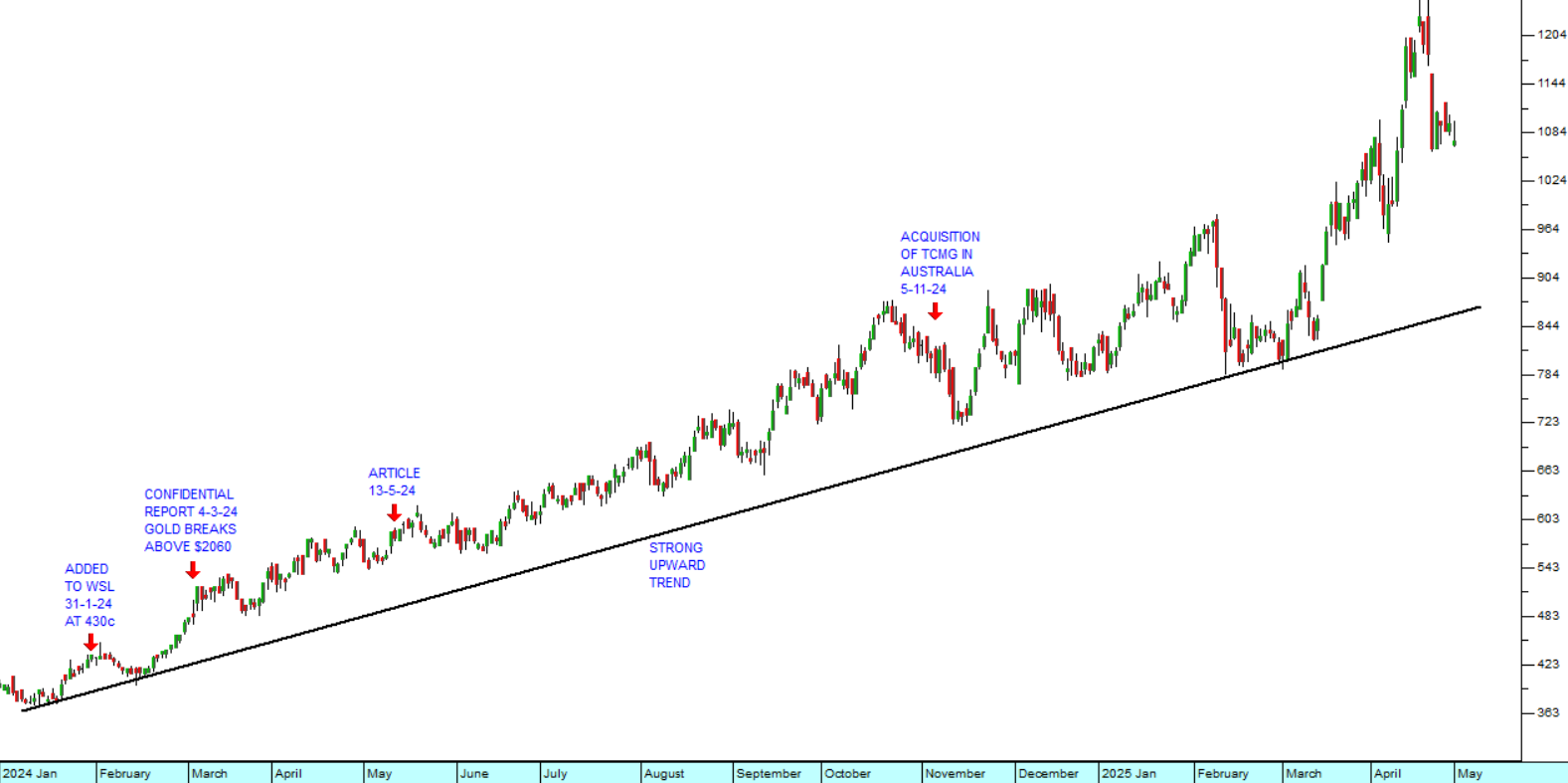
We first added it to the Winning Shares List (WSL) on the 31st of January 2024 at 430c per share. We drew your attention to the fact that gold had broken up through its long-term resistance level at $2060 in the Confidential Report on the 4th of March 2024. That was followed by our article on Pan African published on 13th May 2024. Later that same year (24-11-24) the company acquired 92% of TCMG in Australia for shares and an initial cash payment of A$3,4m. Since then the share has reached a peak of 1231c on the 16th of April 2025 before falling back to 1075c on the slightly lower gold price. We still believe that this is a good, if speculative, investment.
HARMONY GOLD MINING (HAR)
Harmony has been one of our favourite shares over the past 18 months with its innovative management and the fact that it has gained enormously from the rising gold price. Consider the chart:
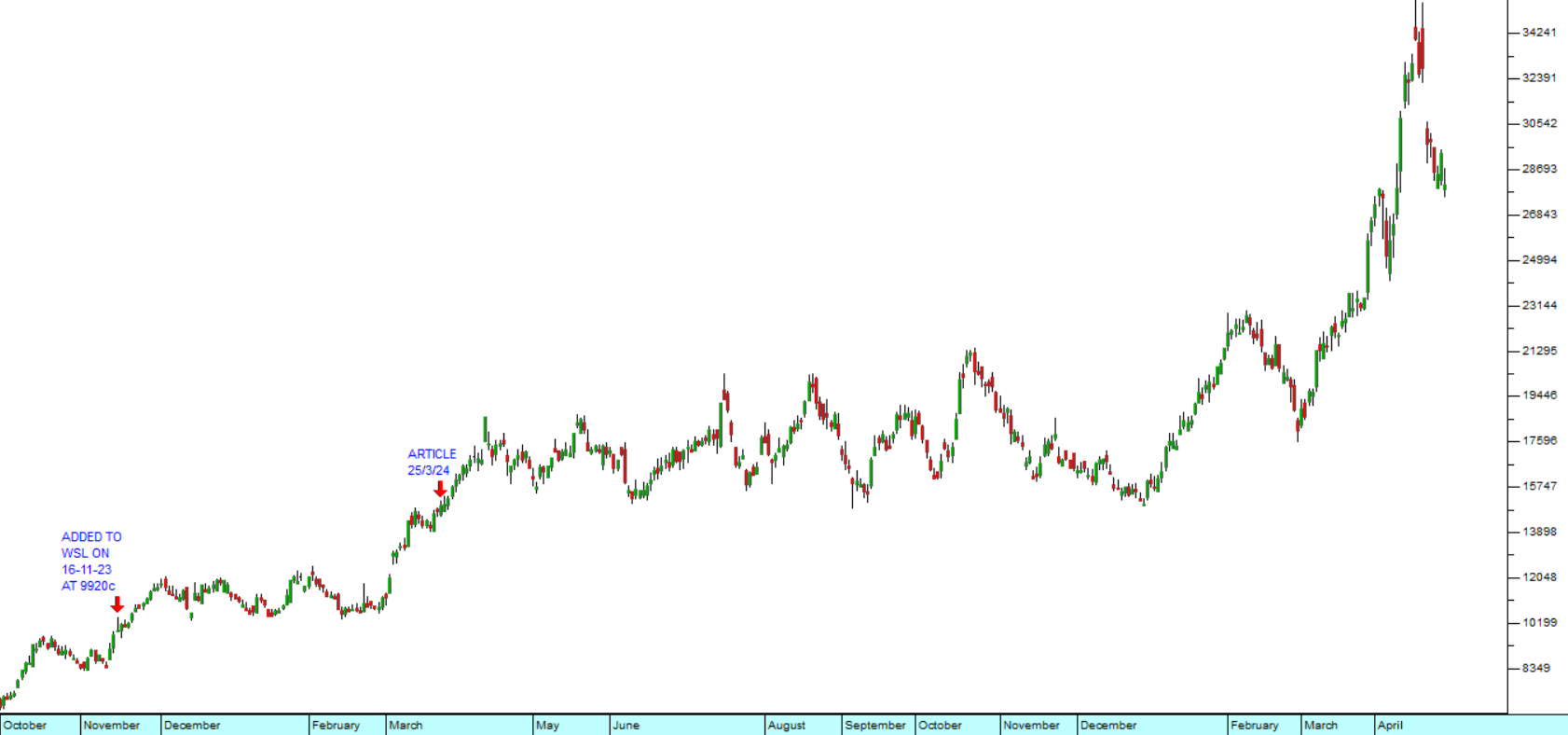
As you can see, Harmony was originally added to the WSL as far back as 16th November 2023 at a price of 9920c. We also then wrote an article about it on the 25th March of 2024 by which time it had reached 14997c. Since then it has sky-rocketed to high of 33094c on the 15th of April 2025, before falling back on the recent decline in the gold price to 28149c. We still regard Harmony an excellent investment – but it remains a speculation on the gold price and the strength of the rand.
DISCLAIMER
All information and data contained within the PDSnet Articles is for informational purposes only. PDSnet makes no representations as to the accuracy, completeness, suitability, or validity, of any information, and shall not be liable for any errors, omissions, or any losses, injuries, or damages arising from its display or use. Information in the PDSnet Articles are based on the author’s opinion and experience and should not be considered professional financial investment advice. The ideas and strategies should never be used without first assessing your own personal and financial situation, or without consulting a financial professional. Thoughts and opinions will also change from time to time as more information is accumulated. PDSnet reserves the right to delete any comment or opinion for any reason.
Share this article: